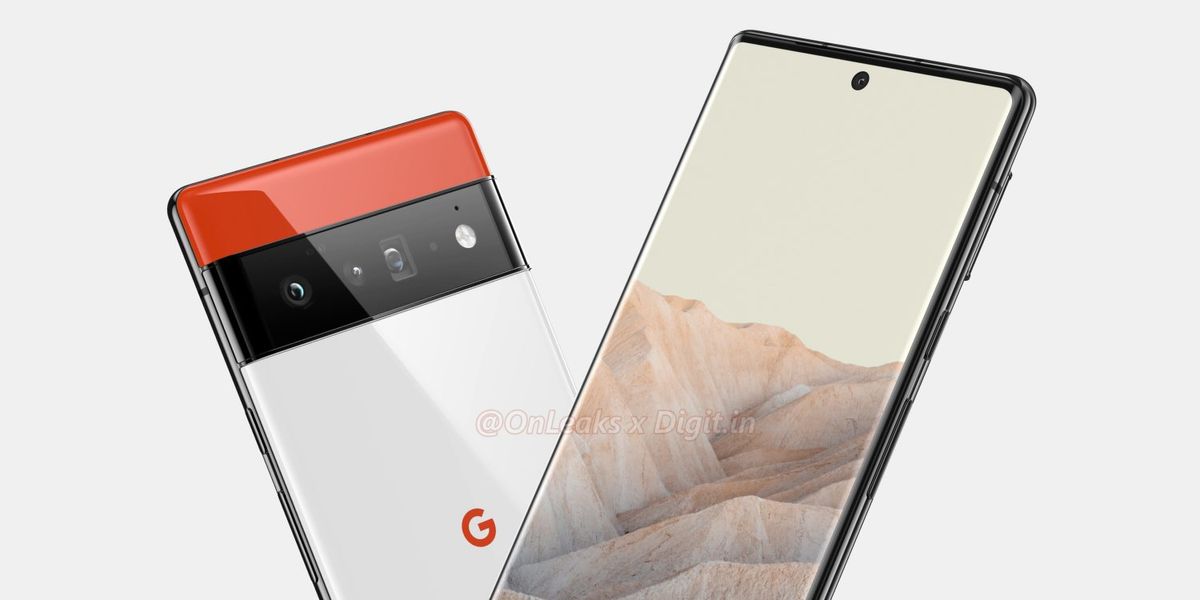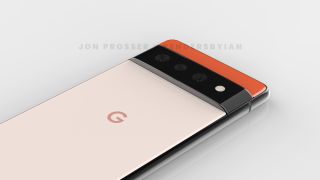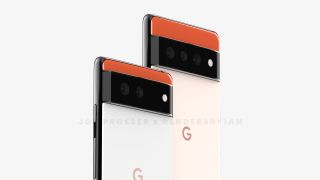Pixel 6 will make me abandon OnePlus once and for all — Here's why
I'm smitten by the Pixel 6 but will Google find a way to ruin the charm between now and launch?

If Pixel 6 rumors hold true, then come this fall, I'll bid adieu to OnePlus and return to the arms of Google. For some background, I've bounced between the two brands for the better part of six years after my OG brand of choice, LG, stopped making compelling products (before fleeing the market altogether). My journey started with a Nexus 6P and I've flip-flopped ever since, most recently landing on the OnePlus 9.
I typically use a phone for several years before upgrading, but everything I'm reading about the Pixel 6 has me excited to jump ship on my OnePlus 9 voyage much sooner than I had anticipated. Returning to Google has little to do with the shortcomings of the OnePlus 9 — I gave it a 4.5-star rating and dubbed it the best phone under $750. What has me closely eyeing the Pixel 6 are aspects of a phone that are most important to me, as well as a less quantifiable allure.
- Best smartphones in 2021
- Best budget phones in 2021
- Best phone deals you can buy right now
The Pixel 6 isn't going to create a seismic wave in the industry; it doesn't flip, fold or roll, and yet, I can't remember being so eager to spend what could be nearly four figures on a smartphone. Let's talk about why that is.
Pixel 6 has a stunning design
When I turn over my OnePlus 9 I feel...nothing. Put it in a police lineup with Samsung and Motorola rivals and nobody would know who committed the crime. The Pixel 6, or at least how it looks in leaked images, speaks to me. I concede that not everyone will take to the design— the Pixel has a certain retro quality that won't appeal to those who want something that looks like it's from the future (see Asus ROG Phone 5). To me, everything about the design works.

It starts with the two-tone color, a design element Google has used to great effect in the past. I'm referring to the glossy/matte finish of the original Pixel; the black and white Pixel 2 with a pop of orange; and the matte-black outline on the white Pixel 4 (don't even get me started on the Oh So Orange model).
We don't know what colors are coming to the Pixel 6, but the most widely circulated leak shows a white (or cantaloupe) phone with a black camera module and a vibrant orange accent that evokes a mid-century aesthetic. Cleverly extending across the width of the phone is a long camera bump that should keep the phone from wobbling when placed on a flat surface. It also creates pleasing symmetry, with the rear panel comprised of three stacked rectangles. On the front is a centered hole-punch camera, the current best location for the selfie cam until under-display versions improve.
Pixel camera hardware (finally) gets upgraded
Old hardware improved by stellar software or groundbreaking software held back by aging hardware — however you look at the latest Pixel cameras, it's clear Google needs to make some changes. The latest info from reliable leaker Jon Prosser suggests the tech giant will do just that. Rumors indicate the Pixel 6 will have a 50-megapixel primary wide-angle lens and a 12MP ultra-wide camera while the Pixel 6 Pro adds a 48MP telephoto snapper.
Stay in the know with Laptop Mag
Get our in-depth reviews, helpful tips, great deals, and the biggest news stories delivered to your inbox.
I'd be disappointed if Google once again deviated from its "Why can't the normal and XL versions be identical" stance — I don't want to pay extra for a larger phone to get the telephoto lens when the standard Galaxy S21 packs a 64MP zoom lens. Regardless, camera buffs will be eager to see what happens when Google's class-leading computational photography meets modern hardware. My hope is to have a proper companion camera for my Nikon Z6. As much as I love my mirrorless camera, the old adage remains: the best camera is the one you have with you, and I can't always lug around my Nikon.

We don't have specs for the cameras, so we can't use the aperture, pixel size and sensor model to get an idea of their capabilities. But the 50MP main shooter brings much greater resolution than the 12MP lens in the most recent models, and the 48MP telephoto lens rumored in the Pixel 6 Pro suggests Google no longer dies on the "software solves everything" hill.
Sean Riley, our senior writer on the phone beat, and I are both concerned about how Google's software-heavy imaging techniques will interact with new hardware. Google mastered the 12MP sensor, but that isn't enough resolution in 2021, especially when you're working with such small sensors. I'll remain optimistic and assume the Whitechapel chip (more on that later) will give Google the control it needs to ensure the cameras deliver better image quality than what other flagship rivals bring to the table. Because if it doesn't, the Pixel 6 would be seen as a failure by many.
Flagship phone with flagship specs
I really liked the Pixel 5. I gave it a four-star rating and had no major criticisms after using the phone for several months. But there was a fly in the ointment, one the size of a dragon: the mid-tier Snapdragon 765G chip used in favor of the Snapdragon 865.
This year, Google is said to be using a Whitechapel chip. What's that, I hear you say?! It's reportedly a custom chip made in partnership with Samsung to compete against the Snapdragon 888. Except, from what we've seen, performance is somewhere between the Snapdragon 888 and Snapdragon 865, which puts it a notch below top flagships. To make up for the gap, Google will rely on AI and machine learning.

I'm interested to hear Google's reason for switching to a proprietary chip and what advantages it will give Pixel 6 owners. Apple is using its M1 and A-series chips to create a harmonious ecosystem, will we see something similar from Google?
Onto other specs, the Pixel 6 is said to have a 6.4-inch AMOLED display while the Pixel 6 Pro will flaunt a massive 6.71-inch AMOLED panel. RAM for the standard model is 8GB while the Pro version gets 12GB. Storage options are similar except the Pro goes up to 512GB. Those specs are all aligned with the current flagship phones.
Battery life should be good. If Whitechapel is more power-efficient than its Snapdragon equivalents and Google flexes its AI muscles to optimize performance, then the Pixel 6 Pro with a (rumored) 5,000 mAh battery and the Pixel 6 with a 4,614 mAh will easily last a full day on a charge. Now here's hoping Google goes with faster charging than what is found on the latest crop of Pixel phones. OnePlus set the gold standard with Warp Charge 65T, which gets the OnePlus 9 to 61% in 15 minutes or 99% in just 30 minutes. It's a game-changer, and charging speeds anywhere near those would be a huge boon for Google's next crop of phones.
Pure Android today, pure Android tomorrow
Pure Android software is another reason why I'm tempted to jump back to Google. OxygenOS is good but nowhere near as close to stock Android as previous OnePlus skins. Borrowing heavily from Samsung, OnePlus' latest software version is filled with bloatware and imposes its own tools and design language. There are features in OxygenOS that I wish were in stock Android, like the App Locker, Gaming mode and OnePlus Switch. Still, I favor the simplicity of no-skin Android found on Pixel phones.
Moreover, Android 12 is proving to be a major overhaul, with smoother animations, clever use of colors and improved usability. For its part, OnePlus is good about updating its phone to the latest versions of Android, and recently committed to providing three major Android updates to flagship devices. Google's Pixel 6 will reportedly receive five years of updates. If true, this could be the selling point the Pixel 6 will desperately need after Google ditched its unlimited Google Photos cloud storage perk.
It's this continued support that makes me feel better about throwing what could be close to $1,000 on a phone. If the Pixel 6 delivers, I could see myself using it for years to come — after all, knowing the software will remain up-to-date from life to death is not something many Android owners can rely upon.
Outlook
I'm already saving for the Pixel 6, or more specifically, the Pixel 6 XL. I know it will likely cost around $1,000, but current rumors suggest Google's next phone could compete against the iPhone 12 (and upcoming iPhone 13). The leaked design is a knockout, the camera is on track to get a major upgrade, the specs align with those from rival flagship phones, and the rumored five years of software support would be an Android-leading bonus.
And still, I'm trying to contain my excitement. We're months away from any of the above information being confirmed, and questions remain about the specs and features we're hearing from rumors and leaks. This is all to say that a lot can go wrong between now and the expected Pixel 6 launch this fall.
Google didn't exactly pave the cleanest runway for the Pixel 6, either. The Pixel 4a 5G, at $499, is one of the best values on the market and the $349 Pixel 4a is no slouch. Taking the opposite route as OnePlus, Google must now convince customers that the flagship Pixel 6 represents a significant enough upgrade from its other wallet-friendly phones to justify the higher price.
Oh, and about the price — if Google isn't aggressive, the Pixel 6 could fall into the same trap as the Pixel 4 and Pixel 5. From what we know, $800 seems reasonable for the Pixel 6 while $850 to $950 could make the Pixel 6 XL a compelling alternative to the OnePlus 9 Pro or Galaxy S21 Plus.
There was a point in 2020 when it seemed like Google would never make another flagship phone. Now, with the Pixel 6, it has a chance to deliver the first Pixel capable of applying pressure to Apple and Samsung since the original model.
Phillip Tracy is the assistant managing editor at Laptop Mag where he reviews laptops, phones and other gadgets while covering the latest industry news. After graduating with a journalism degree from the University of Texas at Austin, Phillip became a tech reporter at the Daily Dot. There, he wrote reviews for a range of gadgets and covered everything from social media trends to cybersecurity. Prior to that, he wrote for RCR Wireless News covering 5G and IoT. When he's not tinkering with devices, you can find Phillip playing video games, reading, traveling or watching soccer.
